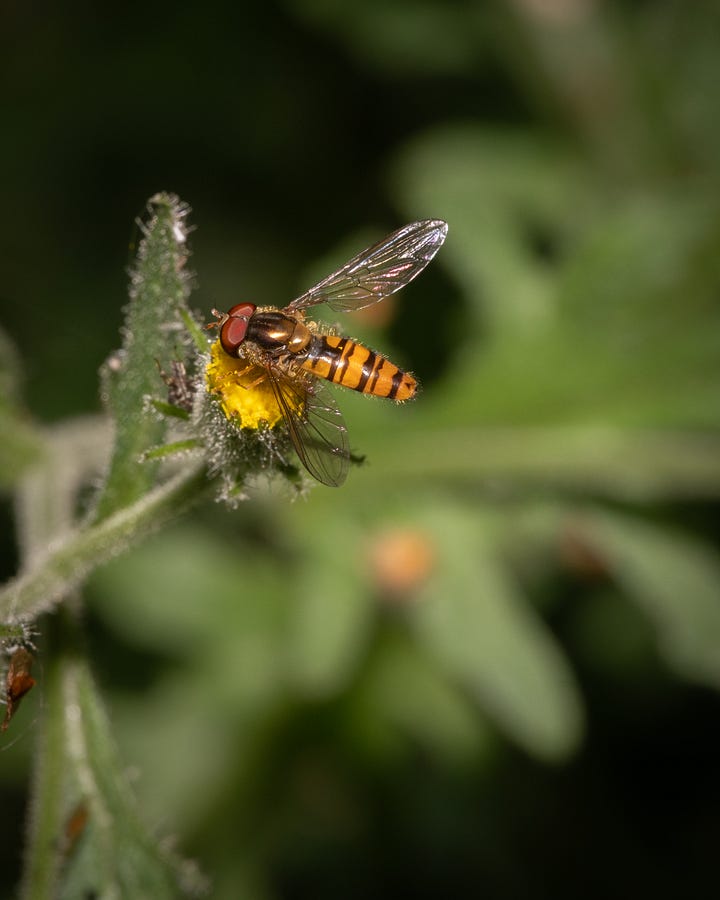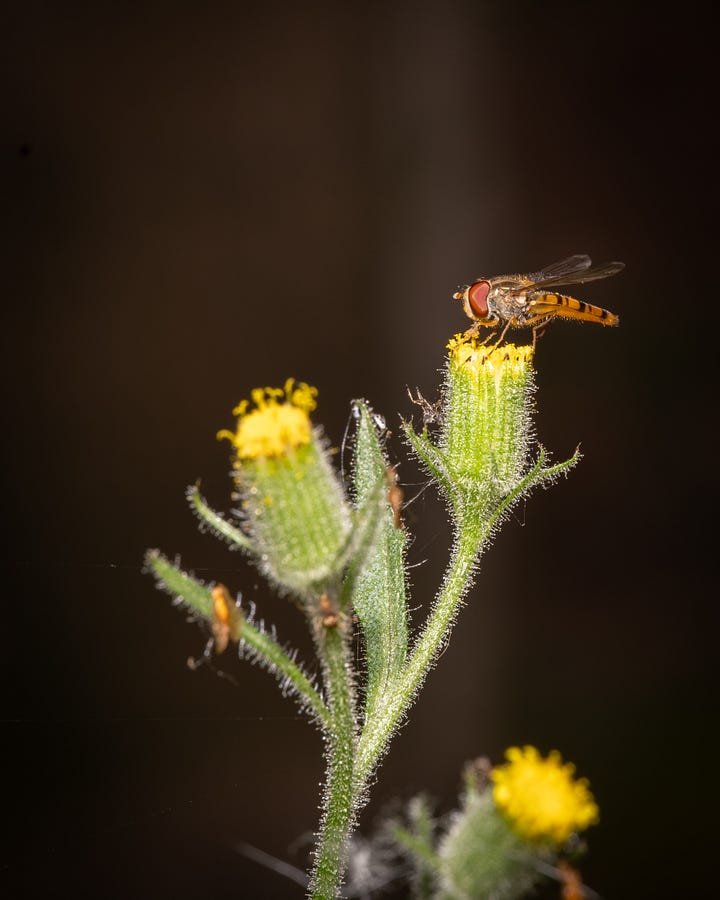A wander with this week's wildlife (8 August 2025)
Dangerous walks, red velvet in the garden and my favourite bird.
I’m afraid I’m not feeling particularly ‘wild’ this week. Endless trips to and from my old house have left very little time for walks without Jasper. And he’s not a wildlife magnet!
I have noticed, on our walks, the dense nettles are at their most rigorous right now. Between those and the exuberant brambles, the footpaths are shrinking down to narrow tracks. Stingy, spiky, narrow tracks!
It’s becoming increasingly dangerous to walk underneath any nut-bearing trees, too. I’ve had clumps of young hazelnuts and several beech masts launched at me by Grey Squirrels. Intentionally? I’m not sure. (I suspect so.)
The rest of this post will make use of last year’s observations from this week. It was another great week for invertebrates. This Marmalade Hoverfly was one of many on the dandelions and other ‘weeds’. It’s the most common species of hoverfly in Central Europe and has a preference for yellow flowers.


The first photo is of a male, as the eyes touch together in the middle. The next photo, there appears to be a gap, which means it’s a female. While this information sounds useless, remember it – it also applies to Horseflies, and female Horseflies are the ones that bite.
And this little Red Velvet Mite – what a find this was!
They are so-called because… well, look at it. They’re luxurious. This one has caught an unlucky seed bug of some kind, possibly birch catkin, and is going to devour it.
At only 4mm long and with that velvety appearance, they are one of the most endearing arachnids you might find on your plants.
Once you’ve stopped digging around in the leaf litter for mites, this is a great time of year to look up. The Swifts have gone, but the House Martins and Swallows are still preparing for their long flight south. They chirp and chatter away as they catch flies in ever-growing flocks.
But if you’re very lucky – and especially near large bodies of water – you may spot a larger, equally aerodynamic bird: the Hobby.
This noisy photo is far from what I prefer to share with you, but these birds are fast and they fly very high up, often with the sun directly behind them. So this will do – especially as you can see the main identifying features:
The black mask. Although this is also seen in Peregrines, these birds are smaller, slimmer and have two other unique features.
The vertical stripes on the chest. Sparrowhawks and Peregrines have less distinct, horizontal marks.
The orange ‘trousers’. You can just make them out below the vertical stripes. Mature male Sparrowhawks do have a reddish tint to their throat and flanks that sometimes extends to their leg feathers, but in Hobbies it is very pronounced, present on both (adult) sexes and limited to just the legs and underneath of the tail.
These remarkable hunters can be seen snatching dragonflies out of the air – no mean feat – and eating them as they fly. In lieu of a better photo, this stock image/illustration does the trick (though I have to question whether they ever really perch with their prey in their feet, given the above description of their mode of hunting).

I am finding that the burden of an unwanted house move has dampened my ability to write. Every few lines, I scroll up to see if I have written ‘enough’, yet. Previous weeks, I’ve struggled not to write ‘too much’!
So I will finish here with another stock photo, because I can’t find my own picture of this beautiful bird that never fails to cheer me up – the Bullfinch.

I love that adorable face and beautiful blush colour, not seen on any other British bird. Bullfinches are in the UK year-round and make a delightfully melancholy ‘fewww, fewww’ call that helps you locate them in the summer foliage.
And here’s the female, who I believe is equally as beautiful. There’s something about that enormous wedge of a beak that looks like a weapon paired with their meek-yet-jaunty expression that just makes me smile.

I hope to go to a nature reserve for the day next week, which will provide me with the photographic fuel and mental fortitude to write the next edition with a bit more vigour. Thanks for bearing with me!
Just two asks:
Let me know what you’ve seen this week in the comments. It always makes me smile!
If you aren’t also receiving my Birdfolk posts that introduce a different bird each week and you’d like to, add it onto your list by going to your profile settings and finding 'Birdfolk’ in your list of subscriptions. This week’s was a slightly shocking introduction to the Great Tit. Next week’s is the Woodpigeon – which so far looks to be a bit less of a horror story.
See you next week!
Gem





A day at Hickling yesterday provided the following;
Little and Great White Egret
Kingfishers
Water Rail
Hobby
Marsh Harrier
Common Tern
Avocet
Mute Swan ( possibly 200)
Swallowtail Butterfly
Bullfinches are amazing! I love how they pair for life and how they sit swinging side by side on the feeders! So cute.